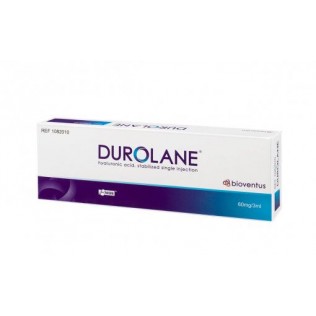 View larger
View larger 232165
Durolane Hyaluronate Sodium 60 mg syringe 3 ml
-10%
250,00 €
224,95 €
Durolane Hyaluronic Acid 2% Jeringa 3 ML
Interarticular injection of Hyaluronic Acid.
Direct treatment to the joint affected by osteoarthritis. It helps to prevent or delay knee or hip artoplasia. Treatment of arthroscopy.
With this product, you earn 449 loyalty point(s). 449 point(s) = 4,49 €.
ACTION AND DESCRIPTION
Symptomatic treatment associated with pain of mild to moderate osteoarthritis in the ankle, shoulder, elbow, wrist, fingers and feet, and temperotoxic and facetal joints. It is also indicated for pain from the arthroscopy of joints, either in the presence of osteoarthritis or after a general surgical repair within 3 months.
In the case of DUROLANE (CN 232165.6) also for symptomatic treatment of mild to moderate osteoarthritis in the knee or hip. It has been designed to be used as an intraarticular injection for symptomatic treatment of osteoarthritis from mild to moderate synovial joints indicated and pain after arthroscopic procedures. The injection shall be made by an authorized specialist doctor, or must be made in accordance with the existing local regulations.
Contains 20 mg/ml of non-animal stabilised hyaluronic acid in a tamponated physiological pH 7 sodium chloride solution. It is a transparent and sterile viscoelastic lubricant presented in a 1 ml or 3ml glass syringe. The product is of one use.
Hyaluronic acid is identical in all living organisms. It is a natural polysaccharide present in the body tissues found in especially high concentrations in the synovial fluid and the skin. It is composed of hyaluronic acid produced biosynthetically, purified and stabilized. It is degraded in the body by the same metabolic pathway as endogenous hyaluronic acid.
Hyaluronic acid is a natural part of the synovial fluid and acts in joints as a lubricant for cartilage and ligaments and as a protective effect against mechanical forces. Hyaluronic acid injections in the joint allow to recover viscosity and elasticity, as well as reduce pain and improve joint mobility.
DUROLANE SJ (CN 160694.5)
Clinical studies of other preparations with similar hyaluronic acid for the treatment of osteoarthritis and post-arthroscopy indicate average benefits to the initial situation. Selected studies indicate improvements that favor the group treated with hyaluronic acid with respect to the group with control treatment, such as saline solution and corticosteroids. Pain relief and physical function improvement were observed six months after treatment.
The average life of the product is approximately four (4) weeks.
DUROLANE (CN 232165.6)
Clinical data for the 6 months after treatment with DUROLANE regarding osteoarthritis of the knee and hip show significant average benefits, such as improving the pain and physical function of the hip and knee, compared to the initial situation.
Studies on repetition of treatment on the knee at 6 months of initial injection showed no greater incidence of adverse events.
DUROLANE controlled tests in knee osteoarthritis indicate significant benefits with respect to saline solution and results are not lower with respect to corticosteroids in a population of patients with widely adopted efficacy.
Clinical studies of other preparations with hyaluronic acid similar to DUROLANE in joints different from that of the knee and the hip for the treatment of osteoarthritis and post-arthroscopy indicate average benefits with respect to the initial situation. Selected studies indicate improvements that favor the group treated with hyaluronic acid with respect to the group with control treatment, such as saline solution and corticosteroids. Pain relief and physical function improvement were observed six months after treatment.
The average life of DUROLANE on human knees is approximately four (4) weeks.
Presentation
It is supplied in a glass syringe of 1 ml or 3 ml, with a Luer-lok garrison, introduced in a container with blisters. The content of the syringe is sterile. The outside of the syringe is not sterile.
It is a product designed for unique use. It must not be re-sterilized. It must be used immediately after extracting the syringe from your container. Do not use if the container or syringe are open or damaged. It is not supplied with needles.
Syringe and all unused material should be disposed immediately after the treatment session and should not be reused, as the unused material may have been contaminated and this entails risks such as infections. Its elimination should respect accepted medical practices and national, local or institutional standards.
CONSERVATION AND DACITY
It should be stored in its original wrapper at a maximum temperature of 30 °C. The expiration date is indicated in the packaging and the product should not be used after that date. Avoid submitting the product to freezing.
EMPLEMENTATION MODEL
DUROLANE SJ (CN 160694.5):
It is a single dose preparation and single injection, and should be injected once for treatment. The recommended dose is approximately 1 ml for small synovial joints (small, fingers of hands and feet) and 1-2 ml for intermediate joints (both, ankle). For joints that require a 2 ml injection, an additional syringe will be required. A 3 ml syringe is available for larger joints.
DUROLANE (CN 232165.6):
It is a single dose preparation and single injection, and should be injected once for treatment. The recommended dose is 3 ml for each knee joint, hip or shoulder. The recommended dose is 1-2 ml for intermediate joints (e.g. elbow, ankle) and approximately 1 ml for small synovial joints (e.g. thumb).
General information on administration:
- should only be injected by an authorized doctor (or in accordance with local laws), familiar with the intraarticular injection technique of the synovial joint to be treated, in appropriate facilities for intraarticular injections.
- must be injected by strictly aseptic techniques.
- it should only be injected into the joint cavity.
- in some synovial joints, intraarticular injection should be guided by images in order to ensure proper placement and prevent damage to adjacent vital structures.
- You should choose the intraarticular injection pathway with or without the help of the images so that it does not involve any risk for the adjacent vital structures.
- the injection area should be cleaned with alcohol or other appropriate antiseptic solution before injecting the drug.
- if there is joint effusion, it should be removed before injecting it. The same needle should be used to remove effusion and inject.
- a needle size of 18 to 25 G is recommended, with an appropriate length.
- the use of smaller diameter needles increases the pressure needed to manage the product.
Additional information for the treatment of synovial joints that require image guidance:
- intraarticular injection in the hip and facet joints should be administered under fluoroscopic control (and, if possible, with a contrast product) or ultrasonographic control, in order to ensure the proper placement of the needle in the joint cavity.
- the use of images in the other synovial joints will be decided by the corresponding doctor.
- It is possible to alleviate the discomfort of injection using topical or subcutaneously administered refrigerants.
- Image-guided injection should only be made by experienced medical personnel in this type of administration.
Additional information for post-arthroscopy treatment:
- after the arthroscopic procedure, intraarticular injection should be applied outside the sterile field, since the outside of the syringe is not sterile.
- the smaller joints that are normally subjected to arthroscopic interventions are the elbow, ankle and wrist joints.
Important patient information:
- as in any invasive joint procedure, it is recommended to avoid activities that require effort the first two days after the injection.
- some transient reactions to injection may be anticipated, such as pain and/or swelling/requirement of mild to moderate intensity during the first week after injection. If symptoms persist, the patient should contact a doctor.
PRECAUTIONS AND WARNINGS
It should not be injected if the synovial joint is infected or very swollen.
It should not be injected if the patient has an infection or skin disease in or near the injection area.
It should not be injected intravascularly, or extra-articularly, or injected into the tissues or in the synovial capsules.
Do not re-sterilize; since the product could be damaged.It should be used with caution in patients suffering from venous or lymphatic stasis in the leg.
It has not been tested in pregnant or breastfeeding women, or in children.
A different syringe should be used for each joint of the patient to be treated.
As in the invasive procedure in the joints, there is a small risk of infection.
It should not be injected if the patient is sensitive to products containing hyaluronic acid.
Local anesthesia should not be used if the patient is known to be allergic or especially sensitive to local anesthesia.
Injection under fluoroscopic control will not be done, with the use of a contrast product, if the patient is known to be allergic or especially sensitive to the contrast product.
In the clinical studies performed, re-injections have not been studied at an interval less than 6 months between the first and the second injection.
An increase in the pressure of the injection may indicate an incorrect extraarticular placement of the needle or an excessive filling of the joint.
Its effectiveness is unknown after arthroscopic procedures only for diagnosis or examination.
It should be used with caution in patients who suffer from condrocalcinosis, as the injection could cause an acute crisis of this disease.
Their safety and effectiveness are unknown along with other intraarticular injections.
WARNING REACTIONS
Most of the adverse events reported in clinical trials are pain, swelling, and/or transient stiffness located in the joint.
These adverse reactions were mild to moderate intensity and only occasionally required treatment with analgesics or NSAIDs.
The use of other preparations with hyaluronic acid in other joints did not reveal any additional single adverse reaction.
None of the reported adverse reactions were interpreted as acute inflammatory arthritis or an allergic reaction, and did not require medical attention in the form of surgical intervention, intraarticular or general steroids or antibiotics.











